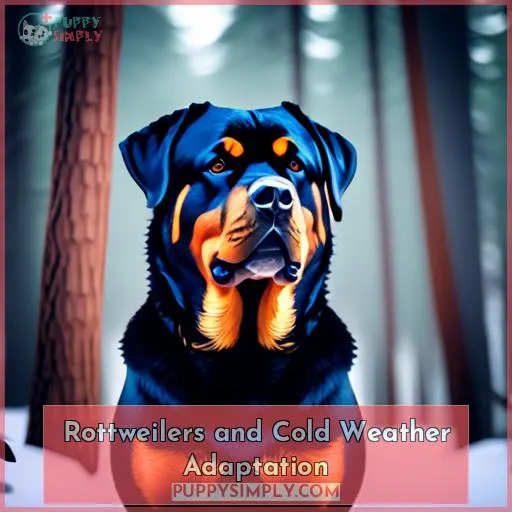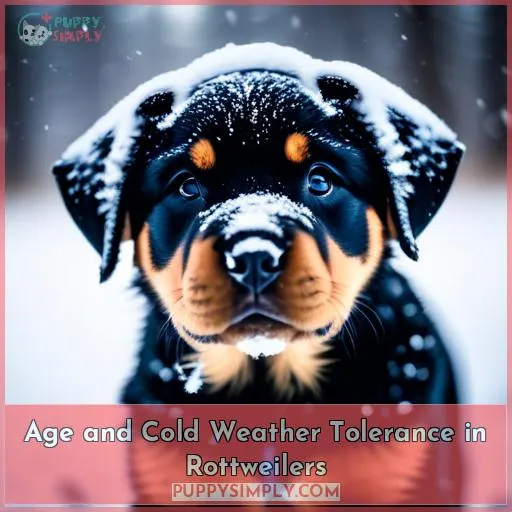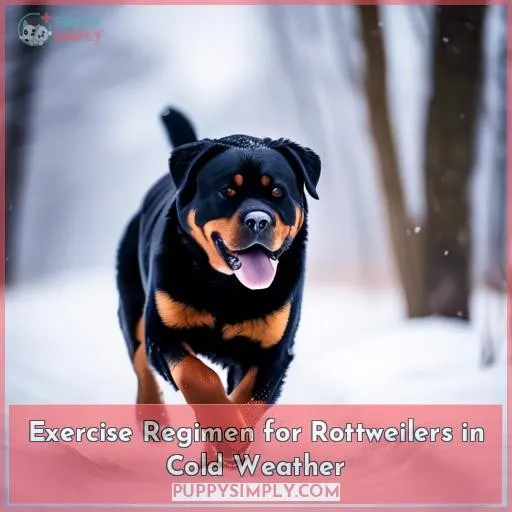This site is supported by our readers. We may earn a commission, at no cost to you, if you purchase through links.

These robust dogs, with their double coats, can handle chilly weather better than many breeds.
However, understanding their limits is crucial for their well-being.
This guide will help you understand how Rottweilers adapt to cold, recognize signs of discomfort, and make necessary adjustments in their care.
Let’s ensure your Rottweiler’s safety and comfort, even when the temperature drops.
Table Of Contents
- Key Takeaways
- Rottweilers and Cold Weather Adaptation
- Understanding Temperature Thresholds for Rottweilers
- Age and Cold Weather Tolerance in Rottweilers
- Indoor and Outdoor Living Arrangements for Rottweilers
- Dietary Adjustments for Rottweilers in Cold Weather
- Exercise Regimen for Rottweilers in Cold Weather
- Recognizing Signs of Discomfort in Cold Weather
- Tips for Rottweiler Care in Cold Weather
- Frequently Asked Questions (FAQs)
- How does the Rottweiler’s coat change with the seasons and how does this affect their cold tolerance?
- What specific health issues can cold weather exacerbate in Rottweilers?
- Are there any specific breeds of Rottweilers that are more resistant to cold weather?
- How does the Rottweiler’s behavior change in cold weather compared to warmer climates?
- What are some emergency measures to take if a Rottweiler shows signs of hypothermia or frostbite?
- Conclusion
Key Takeaways
- Rottweilers have a double coat that provides insulation, making them capable of handling cold weather to an extent, but they should not be left outside in temperatures below 40 degrees Fahrenheit without close monitoring.
- While Rottweilers may enjoy playing in the cold due to their German heritage and dense coats, they are not suited for extreme cold conditions, especially in wet or windy weather, which can significantly lower their body temperature.
- Puppies and senior Rottweilers are particularly vulnerable to cold weather and require extra care, including spending more time indoors during colder months and ensuring a warm, draft-free environment.
- Providing adequate shelter, monitoring outdoor time during cold weather, and adjusting the diet to include more fats and proteins can help maintain a Rottweiler’s body heat and energy levels in colder temperatures.
Rottweilers and Cold Weather Adaptation
You’ve probably noticed your Rottweiler’s enthusiasm for frolicking in the snow.
You’re right to think they’re built for the cold.
Their double coat acts as a natural insulator.
Their German heritage means they’re no strangers to chilly weather.
However, it’s crucial to remember that while they can enjoy the winter wonderland, they shouldn’t be left outside for extended periods in freezing temperatures.
Let’s make sure your furry friend stays warm and happy this winter.
Rottweilers’ Double Coat and Insulation
While you might worry about your Rottweiler’s comfort in cold weather, it’s important to understand that their double coat naturally equips them with insulation against the cold.
Their thick outer coat and softer undercoat provide warmth by:
- Trapping air between hairs to insulate the body.
- Allowing water to run off the outer coat without soaking the undercoat.
- Growing thicker in winter to retain more body heat.
- Shedding in warmer months to prevent overheating.
Native Ability and Adaptation to Cold
You’re naturally equipped to handle the cold thanks to your German roots.
Rottweilers originate from Germany, where winters can get quite harsh. This ancestry has adapted them to withstand frigid temperatures.
Their thick, dense coats provide insulation against the cold.
Still, it’s crucial to monitor Rottweilers in winter temperatures, especially the young and old.
Veterinary check-ups ensure they stay healthy despite temperature.
Understanding Temperature Thresholds for Rottweilers
You’ll need to monitor the temperature when your Rottweiler is outdoors.
Temperatures below 40°F can be risky, and rain or snow will lower their body temperature further.
Keep a close eye on the thermometer and watch your dog for signs of being too cold.
Safe and Risky Temperature Ranges
In determining whether your Rottweiler can stay outside, you’ll need to assess the temperature thresholds for safety versus risk.
Generally, temperatures below 40°F put Rottweilers at risk, particularly puppies and seniors.
Provide adequate shelter, food, water, and limit time outside when it’s cold.
Monitor your dog closely and bring indoors if showing signs of discomfort like shivering or lethargy.
Adjusting their diet, exercise, and shelter provisions can help Rottweilers stay comfortable in cold weather.
Impact of Snow and Rain on Body Temperature
You’ll need to monitor Rottweilers carefully in snow or rain, as wet weather can quickly lower their body temperature and put them at risk in cold conditions.
Frosty paws and a wet coat from snow or rain challenge their insulation, so take special care on snowy and rainy days to warm them when they come inside.
Mind their hydration on cold, wet days too, as chilling water bowls can dissuade drinking.
With some thoughtful winter coat care and attention to warmth and hydration, you can keep your Rottweiler comfortable even when the weather turns wet and icy.
Age and Cold Weather Tolerance in Rottweilers
When considering whether Rottweilers can stay outside in the cold, it’s crucial to factor in their age.
Puppies and older dogs are particularly vulnerable to the harsh effects of cold weather.
They need extra care and should spend more time indoors during colder months.
This approach ensures they remain safe and healthy, adapting your care to suit their specific needs at different life stages.
Vulnerability of Puppies and Older Dogs
While considering the temperature thresholds that Rottweilers can safely endure, it’s crucial to recognize that puppies and older dogs are particularly vulnerable to the cold.
Puppy Precautions:
- Keep them indoors during extreme cold.
Senior Rotties:
- May need extra warmth and comfort.
Cold Weather Exercise:
- Adjust intensity and duration for their age.
Shelter Strategies:
- Ensure a warm, draft-free environment.
Age-Specific Care:
- Tailor their care to their unique needs in cold weather.
Adapting Care for Different Age Groups
Recognizing the vulnerability of puppies and older dogs to cold, it’s crucial that you adapt their care to ensure they remain warm and comfortable during winter months.
Puppy protection involves:
- Cozy indoor adjustments
- Gentle weather exercise
For senior Rotties, consider:
- Softer bedding
- Reduced outdoor time
Winter grooming keeps their coat in top condition, helping them brave the chill with confidence.
Indoor and Outdoor Living Arrangements for Rottweilers
When caring for your Rottweiler during the colder months, it’s important to consider their living arrangements:
- If they’re cozying up indoors, their diet and routine may not need much tweaking.
- If they’re braving the elements outside, you’ll need to ensure they have:
- A natural diet
- Constant access to water
- A warm and safe shelter
Dietary and Living Adjustments for Indoor Rottweilers
Shifting focus to the indoor living arrangements for Rottweilers, it’s important to note that these dogs generally adapt well to indoor environments, with minimal changes needed in their diet or living conditions, even during colder months.
Indoor Nutrition:
- Maintain their balanced diet, with no significant changes required.
Cozy Living:
- Provide a warm, draft-free space for them to rest.
Winter Exercise:
- Keep them active with indoor play and short outdoor walks.
Weather Grooming & Hydration Tips:
- Regular brushing and ample water intake are crucial.
Essential Provisions for Outdoor Rottweilers
For Rottweilers living outdoors, providing a well-insulated and waterproof shelter is essential to protect them from extreme weather conditions.
Outdoor Essentials:
- Insulated Shelter
- Dietary Needs
- Unfrozen Water
Shelter Considerations:
- Waterproof Design
- Elevated Bed
- Windproof Location
Age-specific Care:
- Puppies & Seniors: Adjusted Exercise
- Tailored Nutrition
Dietary Adjustments for Rottweilers in Cold Weather
As the temperatures drop, it’s crucial to adjust your Rottweiler’s diet to ensure they stay warm and energized.
They’ll need more fats and proteins to maintain their body heat, so consider incorporating more calorie-dense foods into their meals.
Keeping them hydrated with adequate liquids is also essential for regulating their body temperature, so make sure they’ve access to water that isn’t frozen.
Consider warm, liquid-based foods like stews.
Importance of Fats and Proteins
How can you ensure your Rottweiler receives the necessary nutrients during the colder months when their energy needs increase?
It’s crucial to adjust their diet to include more fats and proteins, which are essential for maintaining their body heat and energy levels.
Opt for a dietary balance rich in protein sources like meat and eggs.
Hydration needs remain high, so provide ample water, especially after winter exercise, to aid in coat maintenance.
Role of Adequate Liquids in Maintaining Body Temperature
Ensuring your Rottweiler consumes enough liquids is crucial for maintaining their body temperature during cold weather.
Hydration importance can’t be overstated; it’s vital for your dog’s health and comfort.
Winter water needs increase as dry air dehydrates quickly.
A liquid diet benefits their warmth, aiding in body temperature maintenance.
Always provide unfrozen water to support their cold and hydration balance.
Exercise Regimen for Rottweilers in Cold Weather
Keeping your Rottweiler active during the cold months is crucial for their overall health and well-being.
Adjust the duration and frequency of their exercise, making sessions shorter but more frequent.
Importance of Regular Exercise
During cold months, it’s crucial for your Rottweiler’s health to maintain a regular exercise routine, despite the chilly weather.
Outdoor activities offer exercise benefits that are vital for your dog’s physical health and mental stimulation.
Winter playtime keeps their body and mind sharp, ensuring they stay happy and well-adjusted.
So, bundle up and enjoy the season’s unique joys with your four-legged friend.
Adjusting Exercise Duration and Frequency in Cold Weather
Regularly adjusting the duration and frequency of your Rottweiler’s exercise in cold weather is crucial for their well-being.
Tailoring the intensity ensures they stay active without risking their health.
Winter exercise tips often include:
- Shorter, more frequent walks
- Weather-appropriate workouts
By maintaining activity with cold weather routines, you provide your Rottweiler with safety, understanding, and control over their environment.
Recognizing Signs of Discomfort in Cold Weather
When it comes to ensuring the well-being of your Rottweiler during the colder months, it’s crucial to stay vigilant for any signs of discomfort they may exhibit.
If you notice your furry friend shivering excessively, showing reluctance to move, or seeking sources of warmth, these are clear indicators that they’re not coping well with the cold.
It’s essential to act promptly by warming them up and, if necessary, seeking advice from a veterinarian to ensure their health and comfort during winter.
Common Signs of Cold-Weather Distress in Rottweilers
After ensuring your Rottweiler gets adequate exercise in the cold, it’s equally important to keep an eye out for signs of discomfort or distress due to the cold weather.
These signs can include:
- Shivering indicators: Excessive shivering is a clear sign of cold-related distress.
- Behavioral cues: Reluctance to move or play.
- Environmental discomfort: Seeking warmth, huddling.
- Health concerns: Anxiety or changes in behavior.
When to Bring Your Rottweiler Indoors
Following the discussion on common signs of cold-weather distress in Rottweilers, it’s crucial to know when to bring your Rottweiler indoors to ensure their safety and comfort.
If temperatures plummet past thresholds, or if you notice shivering and reluctance to play, it’s time for indoor adjustments.
Always supervise outdoor time to mitigate health risks and maintain control over their winter behavior.
Tips for Rottweiler Care in Cold Weather
When caring for your Rottweiler in cold weather, it’s essential to:
- Keep a close eye on their food, water, and shelter to ensure they stay healthy and comfortable.
- Provide regular coat care and grooming, as a well-maintained coat provides better insulation and protection from the cold.
Monitoring Food, Water, and Shelter
In the midst of cold weather, it’s crucial to keep a close eye on your Rottweiler’s food, water, and shelter to ensure their comfort and safety.
Regular shelter inspections protect them from the elements, while water bowl maintenance prevents freezing.
Monitor food portions to meet their energy needs.
Temperature checks and a cozy bedding arrangement offer additional warmth and security.
Importance of Regular Coat Care and Grooming
As you monitor your Rottweiler’s food, water, and shelter during the cold months, don’t forget that regular coat care and grooming are equally crucial for their well-being.
Employ gentle grooming techniques to minimize stress and maintain coat health.
Keep up with coat maintenance to manage shedding and insulate effectively.
Implement a routine for fur care, including brushing tips to distribute natural oils.
Address shedding management by using the right tools to remove dead hair.
Frequently Asked Questions (FAQs)
How does the Rottweiler’s coat change with the seasons and how does this affect their cold tolerance?
Your Rottweiler’s coat thickens in winter, shedding the heavier undercoat during spring and fall to adapt to changing temperatures.
What specific health issues can cold weather exacerbate in Rottweilers?
Like a winter storm exacerbating a leaky roof, cold weather can worsen certain health issues in Rottweilers.
Hypothermia and frostbite are direct risks, especially for the ears, tail, and paws.
Additionally, conditions like arthritis can flare up in the cold, causing discomfort and mobility issues.
Are there any specific breeds of Rottweilers that are more resistant to cold weather?
No specific breeds of Rottweilers are more resistant to cold weather.
All Rottweilers, originating from Germany, have a double coat that provides insulation against cold.
However, individual tolerance can vary based on:
- Health
- Age
- Acclimatization
How does the Rottweiler’s behavior change in cold weather compared to warmer climates?
Rottweilers revel in the brisk, biting air,
Becoming buoyant buddies in the frosty frolics of winter.
Their demeanor shifts subtly,
Showing a surge in snuggles and seeking warmth with you,
Contrasting their vibrant, vivacious ventures outdoors in mild months.
They’re adaptable, affectionate, and always eager to explore,
Regardless of the thermometer’s tale.
What are some emergency measures to take if a Rottweiler shows signs of hypothermia or frostbite?
If your Rottweiler shows signs of hypothermia or frostbite, immediately:
- Wrap them in a warm blanket.
- Seek veterinary help.
For frostbite:
- Place affected areas in lukewarm water.
- Avoid rubbing or massaging the area.
Always consult a vet for proper treatment.
Conclusion
Navigating the winter months with your Rottweiler is akin to guiding a ship through icy waters.
Just as a vessel needs to be built to withstand the cold, your Rottweiler, with its double coat, is naturally equipped for chillier climates.
However, understanding when the cold becomes too much is vital for their health and happiness.
Can Rottweilers stay outside in the cold? Yes, but with caution.
It’s essential to monitor the temperature, as extreme cold can be harmful, especially for puppies and senior dogs.
Adjusting their care, from providing extra warmth to ensuring they’ve a cozy shelter outdoors, is crucial.
By being attentive and making necessary adjustments, you ensure their well-being, allowing them to thrive even in winter’s embrace.














